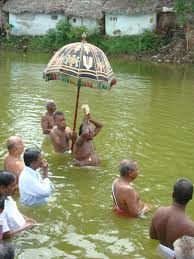Mangalasasanam (Sanskrit: मङ्गलाशासनम्, romanized: Maṅgalaśaṃsanam, lit. 'auspicious felicitations') refers to a Vaishnava concept in Hinduism, where a devotee offers their salutations and felicitations upon God due to a profound sense of concern for the latter, and also as an exercise of forgetting their sense of self.[1]

Hymns
editThe concept of mangalasasanam is often associated with the pasurams (verses) of the Alvars, who during the early medieval period of Tamil history (between the 7th and 10th centuries CE), worshipped Vishnu and his avatars through their hymns. This collection of their hymns is known as the Naalayira Divya Prabhandham. The Sri Vaishnava shrines that were extolled by the Alvars are called the Divya Desams, where a number of these poet-saints offered their mangalasasanam.[2]
| Number of pasurams | 1 | 2 | 4 | 5 | 6 | 7 | 9 | 10 | 11 | 12 | 13 | 14 | 20 | 21 | 22 | 24 | 27 | 32 | 33 | 36 | 39 | 40 | 42 | 45 | 47 | 50 | 51 | 110 | 128 | 202 | 247 |
| Number of Divya Desams | 15 | 8 | 2 | 2 | 2 | 1 | 1 | 23 | 14 | 8 | 5 | 3 | 1 | 2 | 3 | 1 | 1 | 1 | 1 | 1 | 1 | 1 | 1 | 1 | 1 | 1 | 2 | 1 | 2 | 1 | 1 |
Classification
editThe below table provides a classification for the mangalasananams offered by the Alvars:[3]
| Prabandam (Hymns) | Alvars (poet-saints) | Number of pasurams |
| Mudal Āyiram (First thousand) | 947 | |
| Tiruppallandu | Periyalvar | 10 |
| Periyalvar Tirumoli | Periyalvar | 463 |
| Tiruppavai | Andal | 30 |
| Nachiyar Tirumoli | Andal | 143 |
| Perumal Tirumoli | Kulashekhara | 105 |
| Tiruchanda Virutham | Thirumalisai Alvar | 120 |
| Tirumalai | Thondaradippodi Alvar | 45 |
| Tiruppalli | Thondaradippodi Alvar | 10 |
| Amalānathipiran | Thiruppaan Alvar | 10 |
| Kanninum Siru Thāmbu | Madhurakavi Alvar | 11 |
| Periya Tirumoli (Great Hymns) | 1134 | |
| Periya Tirumoli | Thirumangai Alvar | 1084 |
| Thiru Kurun Thāndagam | Thirumangai Alvar | 20 |
| Thiru Nedun Thāndagam | Thirumangai Alvar | 30 |
| Mundram Āyiram (Third thousand) | 701 | |
| Mudal Tiruvantati | Poigai Alvar | 100 |
| Irandām Tiruvantati | Bhoothatalvar | 100 |
| Moondrām Tiruvantati | Peyalvar | 100 |
| Nānmugan Tiruvantati | Thirumalisai Alvar | 96 |
| Tiruviruttam | Nammalvar | 100 |
| Thiru Vāsiriyam | Nammalvar | 7 |
| Periya Thiru Andaathi | Nammalvar | 87 |
| Thiruveḻukutrirukkai | Thirumangai Alvar | 1 |
| Siriya Thirumadal | Thirumangai Alvar | 1 (40) |
| Periya Thirumadal | Thirumangai Alvar | 1 (77) |
| Ramanuja Nootrantati | Tiruvarangathu Amuthanar | 108 |
| Tiruvaymoli | 1102 | |
| Tiruvaymoli | Nammalvar | 1102 |
Gallery
editSome of the famous Divya Desams the mangalasanams were uttered include the following temples:
-
Srirangam Temple
-
Srivilliputhur Temple
Notes
edit- ^ Veṅkaṭanātha (1976). Yadavabhyudayam: A Kavya on the Life of Lord Krishna. Vedanta Desika Research Society. pp. PAGE CLXXXII.
- ^ Ramesh, M. S. (1995). 108 Vaishnavite Divya Desams. T.T. Devasthanams. p. 21.
- ^ "Azhwars and Naalaayira Divya Prabhandam | 108 Divya Desam". Archived from the original on 2012-03-26. Retrieved 2011-06-25.
References
edit- B. S., Chandrababu; S., Ganeshram; C., Bhavani (2011). History of People and Their Environs. Bharathi Puthakalayam. ISBN 9789380325910.
- Chari, S. M. Srinivasa (1997). Philosophy and Theistic Mysticism of the Āl̲vārs. Motilal Banarsidass Publishers. ISBN 9788120813427.
- Dalal, Roshen (2011). Hinduism: An Alphabetical Guide. Penguin Books India. ISBN 9780143414216.
- Das, Sisir Kumar; Sāhitya Akādemī (2005). A history of Indian literature, 500-1399: from courtly to the popular. chennai: Sāhitya Akādemī. ISBN 81-260-2171-3.
- Ramanujan, Attipat Krishnaswami (2005). Hymns for the Drowning: Poems for Vishnu. Penguin Books. ISBN 9780144000104.
- Govindāchārya, Aḷkoṇḍavilli (1902). The Holy Lives of the Azhvârs: Or, the Drâvida Saints. Mysore: G. T. A. Press.
periyazhvar.